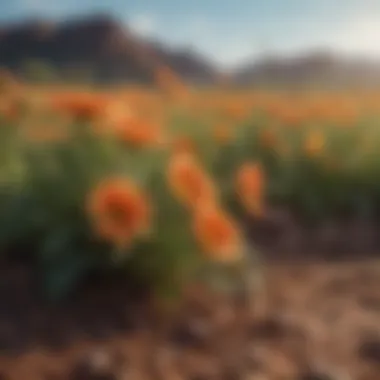Full Sun Flowers in Oklahoma: A Comprehensive Guide


Intro
Gardening in Oklahoma offers unique challenges and rewards. The state's climate, characterized by hot summers and varied soil conditions, presents a distinct environment for planting. This guide aims to help gardeners navigate those challenges by focusing on flowers that thrive in full sun. Not all flowers can withstand Oklahoma's intense sunlight and heat, making it crucial to choose the right species.
Understanding which flowers flourish under these conditions can greatly enhance the aesthetic appeal of any garden. This article will provide insights into planting techniques and care, ensuring that both novice and experienced gardeners can achieve vibrant blooms that last through the summer.
The Importance of Sunlight for Flowers
Sunlight is essential for the process of photosynthesis, where plants convert light energy into chemical energy. In Oklahoma, full sun conditions mean a minimum of six hours of direct sunlight per day. Selecting flowers that can harness this sunlight is vital for healthy growth.
Benefits of Full Sun Flowers
- Enhanced Growth: Full sun flowers typically grow stronger and more robust due to ample light.
- Vibrant Colors: These flowers can exhibit more vivid colors, providing the garden with richness.
- Increased Resilience: Adapted to high light conditions, they are more likely to survive the heat and fluctuating weather patterns.
Fascinating Facts About Full Sun Flowers
Many flowers that thrive in full sun have evolved with particular characteristics.
Unique Characteristics
Certain species exhibit adaptations that help them thrive in hot environments. For example, some have thicker leaves to reduce water loss, while others develop deep root systems to access moisture underground.
Extraordinary Abilities
Some flowers can tolerate extreme heat and drought, making them ideal for Oklahoma's dry spells. These plants not only beautify gardens but also contribute to local biodiversity.
Did you know? Many full sun flowers are also beneficial to pollinators, attracting bees, butterflies, and other insects essential for ecosystem health.
Ideal Flower Species for Oklahoma's Full Sun
When selecting flowers for full sun exposure, it is helpful to consider specific varieties that perform well. Some of the best options include:
- Black-eyed Susan: Known for its bright yellow petals and dark centers, this flower can handle heat with ease.
- Coneflower: This hardy perennial attracts pollinators, adding both beauty and ecological value to your garden.
- Zinnia: Zinnias come in many colors and bloom all summer long, providing consistent visual interest.
- Lantana: A heat-loving plant that produces clusters of colorful flowers and is known for attracting butterflies.
Expert Tips on Planting and Care
To ensure the success of your full sun flowers, follow these guidelines:
- Soil Preparation: Test the soil for pH and nutrients, and amend as needed to create optimal conditions.
- Proper Spacing: Allow adequate space between plants to prevent overcrowding and ensure good air circulation.
- Regular Watering: Water regularly, especially during the establishment phase, but avoid overwatering to prevent root rot.
- Fertilizing: Use a balanced fertilizer to support growth during the blooming season.
By considering the specific needs of each flower type and following these care techniques, you can create a stunning landscape in your Oklahoma garden. Remember that patience and observation are key to understanding what works best in your unique environment.
Understanding Oklahoma's Climate
Understanding the climate of Oklahoma is crucial for those looking to cultivate flowers that thrive in full sun conditions. Climate influences flower selection, growth patterns, and care techniques. Gardeners must grasp how geographical features, temperature variations, and precipitation levels intersect to create unique challenges and opportunities in flower gardening.
Geographical Overview
Oklahoma is situated in the central part of the United States, characterized by diverse landscapes ranging from plains to hills. This geographical diversity impacts climate significantly. The state experiences a mix of humid subtropical and semi-arid climates, providing a variety of growing conditions. In the west, the weather is drier and more arid, while eastern Oklahoma receives more rainfall and humidity. Understanding these regional differences is vital for selecting flowers that will flourish under specific local conditions.
Temperature Patterns
Oklahoma experiences considerable temperature fluctuations throughout the year. Summers can be hot, with average highs often exceeding 90°F (32°C) in July. Winters, on the other hand, can be quite cold with temperatures occasionally dropping below freezing. These temperature changes have direct implications for flower growing. Heat-loving plants are favored for summer blooms, while some may require protection or specific planting times to withstand the coldest months.
Precipitation Levels
Precipitation in Oklahoma varies significantly by region. The eastern part of the state sees more rain, averaging around 40 inches annually, while the western areas may receive less than 20 inches. This variance affects soil moisture levels and consequently influences the types of flowers that can be successfully grown. It is important for gardeners to consider local precipitation levels when planning their gardens, particularly in terms of irrigation needs and drought resistance.


Understanding these climatic factors enables gardeners to better prepare for planting and caring for flowers that thrive in the Oklahoma environment. It is essential to select species that can cope with both the heat of summer and the occasional chill of winter.
Soil Conditions in Oklahoma
Understanding the soil conditions in Oklahoma is crucial for successfully growing full sun flowers. The type and quality of soil directly influence the growth patterns, health, and resilience of flower species. This knowledge helps gardeners make informed decisions, ultimately leading to vibrant and flourishing landscapes.
Types of Soil Found
Oklahoma's diverse landscape features several soil types. Different regions may have specific characteristics that affect the selection of compatible flowers.
- Clay Soil: Commonly found in eastern parts of the state, this soil retains moisture but may drain poorly. It can lead to root rot if flowers are not suitable for such conditions.
- Sandy Soil: Predominantly located in the western regions, sandy soil offers excellent drainage but can dry out quickly. Selecting drought-resistant flowers is essential here.
- Loam Soil: A mixture of sand, silt, and clay, loam soil is considered ideal for growing a variety of flowers. Its balanced texture supports good drainage and moisture retention.
Soil pH and Nutrient Considerations
Soil pH is another vital aspect to consider, as it affects nutrient availability. Most flowers thrive in slightly acidic to neutral soil, with a pH range of 6.0 to 7.0. Testing the soil pH can help gardeners adjust it accordingly. Here are some key nutrients that flowers generally require:
- Nitrogen: Crucial for leaf growth and overall plant vigor.
- Phosphorus: Important for root development and flowering.
- Potassium: Enhances the plant's ability to withstand stress and disease.
Gardeners should consider conducting soil tests to determine nutrient levels and pH. This allows for informed amendments, ensuring a flourishing garden.
Improving Soil Quality
Improving soil quality is essential for successful flower growth. Here are some effective methods for enhancing soil conditions:
- Composting: Adding organic matter enhances soil structure, nutrient content, and moisture retention.
- Mulching: Applying mulch helps retain moisture, regulate temperature, and suppress weeds. This benefits flower health.
- Cover Crops: Growing plants like clover or rye during off-seasons enriches the soil and prevents erosion.
- Soil Amendments: Adding lime can increase pH levels, while sulfur can lower it, depending on specific flower requirements.
By focusing on soil conditions, gardeners can create a robust foundation that supports vibrant blooms thriving under the Oklahoma sun.
Best Full Sun Flowers for Oklahoma
In Oklahoma, the selection of flowers for full sun areas is crucial. The right flowers can not only survive in these conditions but also thrive and add beauty to any landscape. When choosing flowers, it is important to consider factors like climate resilience, maintenance requirements, and contribution to local biodiversity. Selecting the best full sun flowers ensures vibrant blooms and supports local wildlife, enhancing the overall ecosystem.
Native Species
Native plants are vital for maintaining ecological balance. They have adapted to the local climate and soils, making them more resilient and easier to care for.
Black-eyed Susan
Black-eyed Susan (Rudbeckia hirta) is a standout choice for sunny gardens. This flower is known for its bright yellow petals and dark center, which attracts pollinators. The plant can reach heights of 1 to 3 feet and thrives in various soil types, provided they are well-drained. The main advantage of Black-eyed Susan is its ability to bloom from mid-summer to fall, providing color even in the heat. However, they may require deadheading to encourage further blooming and prevent a messy appearance.
Purple Coneflower
Purple Coneflower (Echinacea purpurea) is another excellent native option. It is recognizable by its large purple flowers with central cones that can be a striking focal point in any garden. This species is drought-resistant, making it suitable for Oklahoma's variable climates. One unique feature of the Purple Coneflower is its medicinal properties, historically used to boost the immune system. While generally easy to grow, it can be susceptible to rust, a fungal disease that may require monitoring.
Indian Blanket
Indian Blanket (Gaillardia pulchella) is celebrated for its vibrant red and yellow blooms. This flower is a true sun lover, requiring full sun conditions to flourish. Its unique feature is its long blooming period, often lasting from spring until late fall. Indian Blankets also attract butterflies, enhancing biodiversity in the garden. They can spread quickly, which is great for coverage but may require some control to prevent them from overtaking other plants.
Non-native Considerations
While native flowers are beneficial, non-native species can also add diversity to gardens, especially when thoughtfully selected.
Zinnias
Zinnias are popular for their bright, bold colors and long blooming season. They are easy to grow and require full sun to thrive, making them a suitable choice for summer gardens in Oklahoma. One key benefit of Zinnias is their resistance to many pests, which simplifies maintenance. However, they may need regular watering in extreme heat to stay vibrant and healthy.
Petunias
Petunias are well-loved for their stunning array of colors and versatile growing habits. They perform well in sunny locations and can be grown in containers or garden beds. The unique characteristic of Petunias is their ability to attract hummingbirds, which can add life to any garden. However, frequent deadheading may be necessary to maintain their appearance and promote continuous blooming.


Marigolds
Marigolds are known for their vibrant yellow and orange blooms and ability to deter pests. They are simple to grow and adapt well to Oklahoma's climate. The main advantage of Marigolds is their capacity to thrive in various soil conditions, and they can bloom throughout summer. On the downside, Marigolds might face issues with fungal diseases in overly humid conditions, requiring attention from gardeners.
Perennials vs.
Annuals
When selecting flowers, it is important to distinguish between perennials and annuals. Perennials return year after year, offering a long-term investment for gardeners. They often require less maintenance once established. In contrast, annuals complete their life cycle in one season and can provide vibrant color quickly. Both types have their benefits in full sun gardens. Choosing a mix of both can create a dynamic and colorful landscape that changes throughout the seasons.
Planting Techniques
Understanding proper planting techniques is essential for cultivating flourishing flowers in Oklahoma's full sun environment. The right approach can significantly influence the health, growth, and longevity of your chosen plants. Effective techniques simplify the gardening process, reduce potential issues, and maximize your blooms' vibrancy. This section covers vital aspects that every gardener should consider when planting flowers.
Choosing the Right Location
Selecting an appropriate location for your flowers is crucial. Full sun flowers require at least six hours of direct sunlight daily. Look for spots that are unobstructed by trees or tall structures. Consider your garden's orientation; south-facing areas usually receive more light and warmth.
Soil drainage is another factor to remember. Avoid low-lying areas where water accumulates, as this can lead to root rot. Optimal locations would be slightly elevated with well-drained soil. Additionally, think about accessibility for watering and maintenance. A well-placed garden allows for easier tending.
Spacing and Arrangement
Proper plant spacing and arrangement enhance air circulation and light exposure, significantly affecting plant health. When planting flowers, follow general guidelines; for instance, perennials like Black-eyed Susans should be spaced about 12 to 18 inches apart, while annuals like Zinnias may only require a foot.
Arranging flowers by height can create a visually appealing garden. Taller varieties should be placed towards the back or the center, while shorter plants should occupy the front or outer edges. This prevents taller plants from overshadowing their smaller companions. Consider color coordination and bloom time as well for a diverse display throughout the seasons.
Timing for Planting
Timing is a vital consideration in any successful gardening venture. In Oklahoma, the best time for planting full sun flowers is usually after the last frost date. Depending on the variety, warmer soil temperatures may also be necessary for optimal germination. For instance, many annuals can be planted in late spring, while some perennials do better when started in early spring or fall.
Planning ahead for seasonal changes can ensure your flowers receive the conditions they need. Utilizing a planting calendar can help track regional climate patterns and schedule planting activities accordingly. This helps avoid premature planting, which can lead to poor establishment and reduced blooms.
Important Note: Always consider local climate differences even within Oklahoma, as these can impact planting times.
By paying attention to these planting techniques, gardeners can set the foundation for a robust and colorful garden that thrives in Oklahoma's full sun conditions.
Flower Care and Maintenance
Flower care and maintenance play a crucial role in the growth and beauty of full sun flowers in Oklahoma. Understanding the specific needs of these plants can lead to a thriving garden full of color and life. Proper care enhances resilience and fosters a vibrant ecosystem that attracts various wildlife, including important pollinators.
Watering Techniques
Effective watering is essential for the health of full sun flowers. These plants often require more water in the hot, dry months that characterize Oklahoma's climate. Here are some recommended techniques to ensure optimal hydration:
- Deep Watering: Instead of frequent shallow watering, opt for infrequent deep watering. This encourages deeper root growth and improves drought resistance.
- Morning Watering: Watering flowers in the morning helps reduce evaporation and protects against fungal diseases that can develop in damp conditions.
- Mulching: Applying a layer of mulch around the base of flowers can help retain soil moisture.
These practices are important not just for the immediate health of your flowers but also contribute to a sustainable garden that thrives long-term.
Fertilization Practices
Proper fertilization is vital for the growth and blooming of flowers. For full sun varieties in Oklahoma, consider the following:
- Soil Testing: Before fertilizing, conduct a soil test to determine nutrient deficiencies. Adjust the type of fertilizer accordingly.
- Balanced Fertilizers: Using a balanced fertilizer created for flowering plants can promote blooms while ensuring overall plant health.
- Organic Options: Consider organic fertilizers, such as compost or well-rotted manure. These options enrich the soil and provide slow-release nutrients, benefiting the plants and the environment.
Regular monitoring of soil and plant health can help tailor fertilization to the specific needs of your garden, ensuring robust growth.
Pest and Disease Management
Maintaining the health of full sun flowers requires vigilance against pests and diseases. Here are ways to manage these threats:


- Regular Inspection: Check plants regularly for any signs of pests or disease. Early detection can prevent larger infestations.
- Natural Predators: Encourage beneficial insects, like ladybugs and lacewings, that prey on harmful pests. This can help maintain a balanced ecosystem.
- Proper Spacing: Adequate spacing between plants improves air circulation, reducing the likelihood of fungal diseases.
Incorporating these practices not only protects individual plants but also contributes to a healthier environment overall.
Seasonal Considerations
Understanding seasonal considerations is crucial for gardeners in Oklahoma. The variations in climate throughout the year significantly impact the growth and maintenance of full sun flowers. Each season presents its own set of challenges and opportunities for successful gardening. By adapting practices to seasonal changes, gardeners can ensure their flowers thrive.
Spring Planting Best Practices
Spring is a key time for planting in Oklahoma. As temperatures begin to rise, it is essential to prepare the soil properly. Here are some best practices:
- Soil Testing: Conducting a soil test helps understand pH and nutrients, ensuring ideal conditions for flower growth.
- Timing: Wait until the last frost date has passed to plant tender annuals. This typically falls around mid-April in much of Oklahoma.
- Seed Selection: Choose flower varieties that are well-suited to Oklahoma’s climate, such as Zinnias and Black-eyed Susans.
- Planting Depth: Follow the recommended planting depth on seed packets for optimal germination.
Summer Maintenance
Summer maintenance is vital for sustaining the health of full sun flowers. As the heat intensifies, flowers require more attention. Here are some important aspects:
- Watering: Deep watering is crucial during this season. It's best to water early in the morning or late evening to reduce evaporation.
- Mulching: Applying a layer of mulch conserves moisture and suppresses weeds, which can compete for resources.
- Pest Monitoring: Regularly check for pests. Early detection of common problems like aphids or spider mites can prevent larger infestations.
Fall Preparations
As summer transitions to fall, preparing for the cooler months is necessary to encourage future growth. Recommendations for fall preparations include:
- Deadheading: Remove spent flowers to promote further blooming and improve plant health.
- Soil Amendment: Incorporating compost in the fall can enhance soil quality for next spring.
- Planning for Winter: Consider planting perennials that will provide structure and nourishment for pollinators during the winter months.
It is essential to adapt gardening techniques to the changing seasons. This not only promotes flower health but also supports local ecosystems.
Encouraging Wildlife
Encouraging wildlife is a vital aspect of nurturing a healthy garden in Oklahoma. It impacts not just the garden's aesthetic appeal but also its ecological functionality. Creating a habitat that supports various forms of wildlife, especially pollinators, enhances the overall health of the ecosystem. An increase in biodiversity can lead to better pollination of flowers, control of pest populations, and a more vibrant garden. This section underscores why integrating wildlife encouragement strategies is beneficial for gardeners and the environment alike.
Attracting Pollinators
Pollinators such as bees, butterflies, and hummingbirds play a crucial role in the life cycles of many plants, including flowers that thrive in full sun. Planting a diverse array of flowering species can create an inviting environment for these important creatures. Here, several strategies can enhance pollinator attraction:
- Plant native species: Native flowers are often better suited to local pollinators. Species like Black-eyed Susan and Purple Coneflower not only thrive in Oklahoma's climate but also attract bees and butterflies.
- Provide a variety of blooms: A seasonal variety of flowers ensures that there are blooms available from spring to fall. This continual supply promotes stable pollinator populations.
- Avoid pesticides: Using chemical treatments can harm pollinators. Organic gardening practices can help maintain their populations.
- Install water features: Small water sources provide essential hydration for pollinators, particularly in the hot Oklahoma sun.
Implementing these practices enhances pollinator health and productivity, leading to a more flourishing garden.
Creating a Balanced Ecosystem
A balanced ecosystem in the garden fosters resilience and encourages wildlife diversity. Here are key elements to consider for maintaining this balance:
- Plant diversity: Varied plant species create habitats for different animals and insects. Each type of flower can support unique pollinators and other wildlife.
- Natural predation: Encouraging the presence of natural predators helps maintain pest populations at manageable levels. Birds, for instance, can control insect outbreaks, reducing the need for external pest control measures.
- Shelter and nesting sites: Including native shrubs and trees can offer shelter for birds and other wildlife. Many species require specific types of structures for nesting.
By holistically approaching garden design and management, a gardener can create an ecosystem that not only supports their flowering plants but also enriches the broader environment in Oklahoma.
“Gardening is a partnership between plants, wildlife, and humans. Each plays a role in sustaining the delicate balance of nature.”
Closure
The significance of full sun flowers in Oklahoma extends beyond mere aesthetic appeal. They play a vital role in promoting biodiversity and establishing a sustainable ecosystem within gardens and landscapes. Utilizing native and non-native species that thrive in the intense sunlight of Oklahoma contributes not only to individual gardens but also benefits the larger environment. By selecting the right flowers and employing proper care techniques, gardeners can cultivate vibrant, thriving landscapes that invite wildlife and provide vital habitats.
Additionally, understanding the challenges posed by Oklahoma's climate, such as fluctuating temperatures and varying soil conditions, is crucial. This knowledge allows for informed choices about plant types, ensuring long-term success and resilience against adverse conditions.
"Choosing the right flowers is a key step in creating a flourishing garden that can withstand the Oklahoma sun."
Summary of Key Points
- Climate Adaptation: Full sun flowers are well-adapted to Oklahoma's climate, which features hot summers and variable precipitation. Understanding these conditions helps in selecting suitable species.
- Diverse Flowers: The article highlights a curated list of both native and non-native flowers ideal for full sun conditions, ensuring a beautiful and diverse garden.
- Planting and Maintenance: Effective planting techniques, consistent care practices, and seasonal considerations are essential for the success of any garden. Incorporating these methods leads to vibrant and healthy blooms.
- Wildlife Contributions: Full sun flowers attract a variety of pollinators, aiding in the ecological balance and supporting local wildlife.
- Sustainability Focus: A commitment to selecting flowers that require less water and care can contribute to a more sustainable gardening practice.
Final Thoughts on Full Sun Flowers
Applying the insights offered in this guide will not only improve the appearance of gardens but also increase their ecological value. Full sun flowers enrich our spaces, attract beneficial wildlife, and symbolize our commitment to fostering a harmonious relationship between nature and our living spaces. Moving forward, let us nurture these vibrant blooms and appreciate their role in our gardens and communities.







